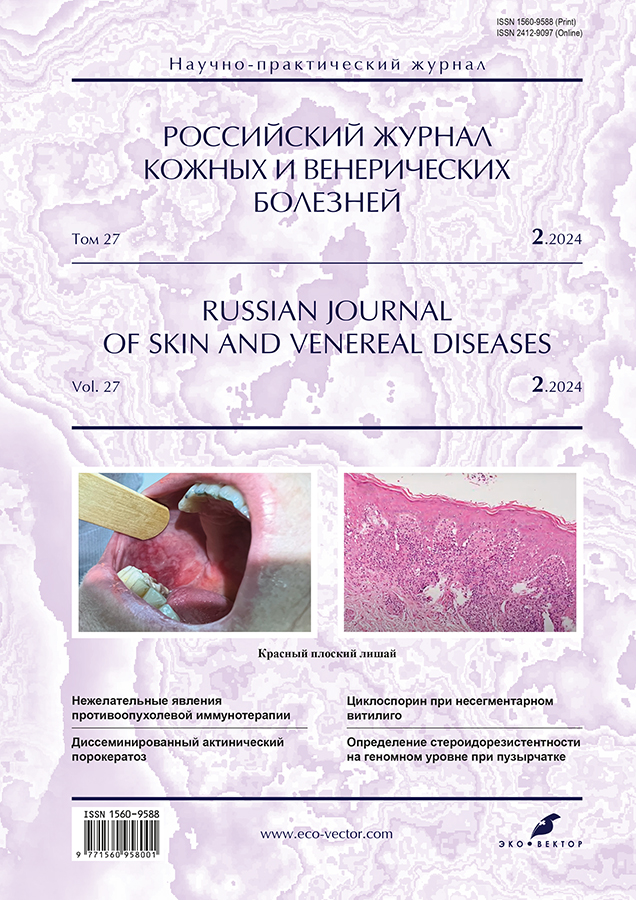Transcranial electrical stimulation (TES) in patients with atopic dermatitis
- Authors: Marchenko V.A.1, Kochergin N.G.1, Dodina M.I.1
-
Affiliations:
- I.M. Sechenov First Moscow State Medical University
- Issue: Vol 27, No 2 (2024)
- Pages: 209-217
- Section: DERMATOLOGY
- Submitted: 18.01.2024
- Accepted: 05.04.2024
- Published: 14.05.2024
- URL: https://rjsvd.com/1560-9588/article/view/625756
- DOI: https://doi.org/10.17816/dv625756
- ID: 625756
Cite item
Abstract
BACKGROUND: Atopic dermatitis is the most common diseases in dermatology, among the main pathogenetic mechanisms of development of which a complex interaction of a genetically determined defect in the barrier function of the skin, an overactive state of the immune system is considered, and a neurogenic theory of disease development is not excluded, which is based on the relationship of anxiety-stress reactions and neuropsychiatric stresses with the occurrence of pathological changes on the skin. Modern atopic dermatitis therapy is characterized by the appointment of a large number of medications according to clinical recommendations, and the associated increase in allergic and toxic-allergic reactions dictates the need to search for new non-drug treatments for this disease. In order to prevent the pathological effects of stress, as well as to increase resistance to its damaging effects, activation of opioidergic mechanisms may be useful.
AIM: To evaluate the effectiveness and acceptability of the transcranial electrical stimulation technique in patients with atopic dermatitis.
MATERIALS AND METHODS: A controlled study was conducted among 60 patients with moderate atopic dermatitis, 33 women (55.0%) and 27 men (45.0%) aged 19 to 72 years. Transcranial electrical stimulation was carried out by a pulsed bipolar electrical stimulator with an acoustic effect "TRANSAIR-07", stimulation was carried out by an electric current with a frequency of 77.5 Hz and a duration of 3.5 ms. Patients underwent 10 procedures, 1 time a day, lasting 30 minutes, with a current of 1−3 mA. SCORAD, EASI, IGA, DLQI, HADS, and BDI scales were used to assess the dynamics of clinical manifestations. The assessment was carried out on the first and last day of treatment.
RESULTS: During statistical data processing, when comparing the scales in the first and last days of the procedures, depending on the patient groups: the 1st group was the main one, received transcranial electrical stimulation treatment in combination with therapy, according to clinical recommendations, the 2nd group was the control group, received treatment according to clinical recommendations, without the use of transcranial electrical stimulation, significant improvement of itching indicators, clinical manifestations and improvement of quality of life after 4 weeks of therapy in both groups. A statistically more significant dynamics of the indicators of the main clinical scales in favor of combination therapy was established: according to the SCORAD scale ― in the main group from 47.50±2.25 to 21.00±1.00, in the control group from 47.00±2.00 to 39.00±1.75; DLQI ― in the main group from 8.00±2.00 to 2.00±0.75, in the control group ― from 8.50±1.50 to 5.00±1.00.
CONCLUSION: The paper presents the positive results of our own research and presents data confirming the clinical effectiveness of transcranial electrostimulation in patients with atopic dermatitis compared with the traditional drug treatment of this disease, which allows us to recommend the treatment regimen we have proposed for widespread implementation in the practice of a dermatovenerologist.
Full Text
About the authors
Violetta A. Marchenko
I.M. Sechenov First Moscow State Medical University
Author for correspondence.
Email: vioshaka@mail.ru
ORCID iD: 0000-0001-9538-8893
SPIN-code: 5981-4242
Russian Federation, Moscow
Nikolay G. Kochergin
I.M. Sechenov First Moscow State Medical University
Email: nkocha@yandex.ru
ORCID iD: 0000-0001-7136-4053
SPIN-code: 1403-3031
MD, Dr. Sci. (Med.), Professor
Russian Federation, MoscowMaria I. Dodina
I.M. Sechenov First Moscow State Medical University
Email: midd@list.ru
ORCID iD: 0000-0003-3759-8942
SPIN-code: 5069-9431
MD, Cand. Sci. (Med.)
Russian Federation, MoscowReferences
- Olisova OYu, Garanyan LG, Arsentiev NS. General aerocryotherapy in combination with narrowband uvb 311 nm phototherapy in patients with atopic dermatitis. Medical alphabet. 2019;1(7):60−62. EDN: ALOZLP doi: 10.33667/2078-5631-2019-1-7(382)-60-62
- Kochergin NG, Afrikyan AA. Atopic dermatitis or eczema? Almanac Clin Med. 2007;(15):200−203. EDN: HZOWXN
- Mikhalchenko VF, Barkova SV. The use of transcranial electrical stimulation in the complex treatment of patients with lichen planus of the oral mucosa. Information and methodological letter for doctors. Volgograd; 2007. Р. 3−4. (In Russ).
- Bilalova UG, Kochergin NG, Kruglova LS. Comparative effectiveness in treating fotoforez tacrolimus torpid atopic dermatitis. Bulletin New Med Technolog. 2013;(1):214. EDN: RSTWIF
- Olisova OY. New potentialities of therapy for atopic dermatitis. Russ J Skin Venereal Dis. 2015;18(6):38−41. EDN: VDWHVZ
- Lebedev VP, Sergienko VI. Development and justification of therapeutic application of transcranial electrical stimulation of brain defence mechanisms using the principles of evidence-based medicine (results of twenty years of research). In: Transcranial electrical stimulation: A collection of scientific articles. Ed. by V.P. Lebedev. Vol. 2. Saint Petersburg; 2005. Р. 11−69. (In Russ).
- Knotkova H, Hamani C, Sivanesan E, et al. Neuromodulation for chronic pain. Lancet. 2021;397(10289):2111–2124. doi: 10.1016/S0140-6736(21)00794-7
- Kochergin NG, Marchenko VA. Application of noninvasive hardware technique of transcranial electrical stimulation (TES) in patients with atopic dermatitis. Russ J Skin Venereal Dis. 2023;26(1):73–78. EDN: BPTYPV doi: 10.17816/dv111901
- Malygin AV, Khadartsev AA, Tokarev AR, et al. Transcranial electrostimulation. Ed. by V.P. Lebedev. Tula State University, Research Centre IM “Pharma 2030”, European Academy of Natural Sciences; 2021. Р. 4−9. (In Russ).
- Barkova SV. Effectiveness of transcranial electrostimulation in the complex treatment of patients with red squamous lichen planus of the oral cavity mucous membrane [dissertation abstract]: 14.00.21. Place of defence: Volgograd State Medical University. Volgograd; 2007. 23 р. (In Russ).
Supplementary files













